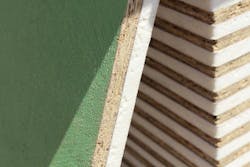Streamlining Building Envelope Materials for Building Teams
A Tale of Two Efficiencies
Efficiency has become a top-of-mind concern in construction. Greater energy efficiency is mandated by codes and regulations. Greater working efficiency is required to stay competitive even as labor costs rise.
Sometimes, the two seem at odds with each other. Constructing an energy-efficient building means making it airtight from the inside, water-resistant from the outside, and very well insulated without thermal bridges—all in addition to fulfilling structural requirements. As each of these performance standards have tightened over the past two decades, compliance has manifested in the forms of new layers added to traditional building envelopes. Each added or increased requirement has been met by a separate product, an additional step in construction. It's been good for energy efficiency, but not necessarily for construction efficiency.
Benefits of Multi-Performance
There are innovative products available that combine more than one aspect of building performance. The line of Zip System® R-sheathing panels, for example, are a single-panel solution with layers of built-in control for water, air, and thermal management. A high-performance engineered wood panel is manufactured with an integrated water-resistive barrier and polyiso foam exterior insulation built-in. Completed with advanced acrylic seam-sealing tape, the exterior wall system provides a streamlined approach to achieving rough-dry, by eliminating the need for loose-applied wrap, with an added benefit of measures to reduce air leakage and protect against thermal bridging or wall cavity condensation.
When the energy efficiency of buildings first came under serious scrutiny, thermal cameras were trained on the exteriors to find out where heat was leaking out. The answer: in every stud. The wall framing stood out in bright red, forming a thermal bridge network between interior and exterior environments. By placing an insulated exterior to the framing, this thermal bridge network is broken, and the insulating ability of the wall assembly is greatly increased.
The application of exterior continuous insulation (CI) is now a prescriptive option in 2015 International Energy Conservation Code. A variety of CI options exist on the market, however, for teams seeking to balance both energy efficiency and jobsite efficiency, many building teams are turning to ZIP System R-sheathing and tape solutions. Originally introduced with a CI thickness providing R-3 and R-6 value, this year the ZIP System R-sheathing product portfolio was extended to offer additional insulation thicknesses to provide R-9 and R-12, particularly to help meet IECC codes with climate zones requiring exterior walls meet these prescriptive values..
As new energy-efficient building codes become more uniformly adopted across the U.S., the necessity of meeting different performance criteria with individual materials, may be less desirable. Specifying products with multiple control layers built-in not only helps efficiently meet evolving building standards, but may also be worth considering to help reduce the risk of improper installation error.
